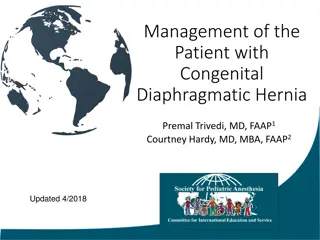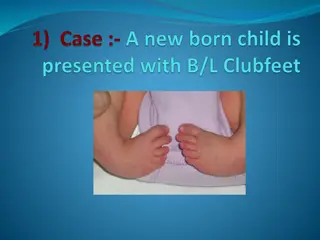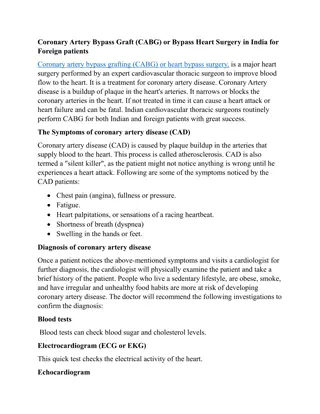Understanding Acute Rheumatic Fever: Causes, Symptoms, and Impact
Acute Rheumatic Fever (ARF) is a multisystem disease resulting from an autoimmune response to a sore throat caused by Group A beta-hemolytic Streptococci. It primarily affects children aged 5-14 years and can lead to rheumatic heart disease (RHD), which is the most common cause of heart disease in c
2 views • 48 slides
Understanding the Natural History of Disease Development and Prevention
The natural history of disease development outlines the progression of a disease in an individual without intervention, from exposure to outcome. Learning objectives include defining prevention terms, understanding disease severity, prevention levels, and intervention measures. Studying disease prog
4 views • 16 slides
Heart Treatment Cost in India
Heart disease is one of the most serious problems that require constant care. Heart treatment cost in India has increased significantly with time. In such a situation, heart treatment is being taken very seriously. A healthy diet must be followed every day. You have to use fiber, heart-healthy eleme
4 views • 2 slides
Find The Top Bariatric Surgery and Heart Disease
Healthy Life Bariatrics offers one of the top bariatric surgery and heart disease clinics in the United States. We provide a safer bariatric surgery and heart disease experience for our patients.
0 views • 8 slides
Heart Treatment in India
Treatment for the heart focuses on reducing excess fluid volume and edema and boosting the heart's pumping ability. The immediate goals include preventing progressive failure or in the worst case, sudden death. The aggressiveness in therapy is proportionate to levels of heart failure. As a common po
0 views • 2 slides
Heart Health Jeopardy - Test Your Knowledge on Heart Disease
Test your knowledge on heart disease with this Heart Health Jeopardy game. Learn about heart disease facts, statistics, risk factors, and common types of heart diseases. Understand the importance of recognizing heart attack symptoms and the significance of factors like high blood pressure, high chol
0 views • 58 slides
Insights into Tyzzer's Disease: An Overview of a Bacterial Infection in Laboratory Animals
Tyzzer's disease is an acute bacterial infection affecting rodents and rabbits, caused by Clostridium piliforme. Discovered in 1917 by Ernest Tyzzer, the disease is characterized by necrotic lesions in the caecal mucosa, liver, and heart. Initially known as Bacillus piliformis, it was later renamed
2 views • 21 slides
Understanding and Nurturing a Healthy Heart: Physical and Spiritual Insights
Delve into the importance of maintaining a healthy heart, both physically and spiritually. Learn about the impact of blockages on heart health, practical tips for physical well-being, and the significance of spiritual stewardship. Explore the connection between heart conditions and stewardship, alon
0 views • 21 slides
Move With Heart - Your Guide to Preventing Heart Disease
Empower yourself and your family to prevent heart disease with small lifestyle changes. Learn your numbers, reduce sodium intake, set nutrition goals, and prioritize physical activity. Discover five activities for a healthier heart, including brisk walking and gardening. Taking just 10 minutes at a
1 views • 7 slides
Understanding Congestive Heart Failure: From Pathophysiology to Clinical Practice
Congestive heart failure (CHF) is a condition characterized by systemic and pulmonary congestion due to the heart's inability to pump sufficient blood for the body's metabolism. It is closely linked to age and involves pathophysiology related to preload, afterload, contractility, and heart rate. Man
0 views • 20 slides
Comprehensive Management of Congenital Diaphragmatic Hernia
This presentation covers the pathophysiology, associated anomalies, diagnosis, consequences, and management of congenital diaphragmatic hernia (CDH). It discusses prenatal interventions, postnatal strategies, anesthetic considerations, and long-term concerns in CDH repair. Understanding the complexi
1 views • 26 slides
Understanding the Impact of Congenital Syphilis in Indiana
Social Vulnerability in Congenital Syphilis cases among mothers in Indiana is a pressing issue. Despite being preventable, the rise in cases signals a failure in detection and care systems. The trend of increasing cases is associated with a rise in infectious syphilis among women. This qualitative a
6 views • 36 slides
Understanding the Impact of Nutrition on Coronary Heart Disease
Explore the relationship between nutrition and coronary heart disease through images depicting blood cholesterol levels, food pyramids for both healthy individuals and those with high cholesterol, and methods to increase fiber in your diet. Understand how cholesterol buildup in arteries can lead to
0 views • 13 slides
Understanding Choledochal Cysts: A Congenital Anomaly of the Biliary Tract
Choledochal cysts are congenital anomalies of the biliary tract characterized by cystic dilatation at various segments. They can lead to complications like biliary cirrhosis and recurrent pancreatitis. Clinical features include jaundice, abdominal pain, and right epigastric mass. Early detection is
0 views • 22 slides
Understanding Congenital Hand Abnormalities and Associated Syndromes
Explore congenital hand abnormalities such as macrodactyly, trigger thumb, clasped thumb, preaxial deficiency, and syndromes like Holt-Oram Syndrome and Fanconi Anemia. Learn about assessment, intervention plans, and common treatments provided by experts in reconstructive plastic and hand surgery.
1 views • 26 slides
Understanding Heart Failure and Congenital Heart Diseases
Heart failure is a condition where the heart struggles to pump blood efficiently, leading to various complications. It can affect different sides of the heart, with causes ranging from coronary artery disease to valve problems. Congenital heart diseases, on the other hand, are common anomalies prese
0 views • 19 slides
Screening for Peripheral Vascular Disease in Patients with Coronary Artery Disease
Patients with coronary artery disease should be screened for peripheral vascular disease as it is a frequent integrator of global cardiovascular risk. The association of atherosclerosis in various arterial diseases highlights the importance of identifying multisite artery disease. The prevalence and
0 views • 23 slides
Understanding Akabane Disease: Causes, Symptoms, and Prevention
Akabane disease, also known as Enzootic Bovine Arthrogryposis and Hydranencephaly, is a viral illness transmitted by arthropods that primarily affects calves, lambs, and kids. The disease can lead to congenital abnormalities such as joint immobility and absence of the cerebral hemisphere. It is caus
2 views • 19 slides
Human Disease Symptom Network: Understanding Disease Relationships Through Symptoms and Genes
The Human Disease Symptom Network (HSDN) is constructed using a large-scale medical bibliographic records database to form a network of human diseases based on symptom similarities. By integrating disease-gene associations and protein-protein interaction data, correlations between symptom similarity
0 views • 37 slides
Benefits and Risks of Exercise in Congenital Heart Disease
Exploring the definitions of congenital heart disease and exercise, this content delves into the benefits and risks associated with physical activity for individuals with CHD. It highlights the importance of different types of exercise, from dynamic to static, and explains the distinctions between m
0 views • 33 slides
Congenital Heart Surgery Database Training and Updates - October 17, 2023
In the upcoming event on October 17, 2023, the Society of Thoracic Surgeons will host a webinar focusing on the Congenital Heart Surgery Database along with essential updates and education for STS data managers. The session will cover a wide range of topics such as case inclusion requirements, data
0 views • 54 slides
High-Sensitivity Cardiac Troponin in Stable Ischemic Heart Disease
Study by Nicholas Marston, MD, and team shows that high-sensitivity cardiac troponin at any detectable concentration is linked to a higher risk of major cardiovascular events in patients with stable ischemic heart disease. The research, conducted through the PEGASUS-TIMI 54 trial, aimed to further u
0 views • 17 slides
Club Foot (Congenital Talipes Equinovarus): A Comprehensive Overview
Club foot, also known as Congenital Talipes Equinovarus, is a condition characterized by a tri-planar deformity of the foot. This article covers the aetiology, clinical features, diagnosis, treatment options, and patient management strategies for club foot. It discusses the gene variations, environm
0 views • 26 slides
Causes and features of cyanotic congenital heart disease
This informative content covers the causes and features of cyanotic congenital heart disease, including central cyanosis due to congenital heart diseases like Tetralogy of Fallot, pulmonary atresia, Ebstein anomaly, and more. It also discusses non-cardiac causes of cyanosis related to lung diseases,
0 views • 41 slides
Understanding Birth Defects: An Overview of Congenital Anomalies
Birth defects refer to abnormalities present in babies at birth, regardless of genetic or prenatal causes. They affect 2-3% of babies in the US, making them a leading cause of infant mortality. Structural defects like cleft lip/palate, spina bifida, and club foot can impact a child's health and deve
0 views • 17 slides
Specialised Commissioning for Congenital Myasthenic Syndromes - Overview by Professor Jacqueline Palace
Delve into the highly specialised commissioning of Congenital Myasthenic Syndromes by Professor Jacqueline Palace from the Nuffield Department of Clinical Neurology at John Radcliffe Hospital, Oxford. Explore key messages, learning objectives, and disclosures related to diagnosing, differentiating,
0 views • 4 slides
Understanding Heart Health and Disease Prevention Through Diet
Heart disease is a prevalent global issue, with cardiovascular diseases leading to millions of deaths annually. Lifestyle modifications, including dietary changes, play a crucial role in managing heart health. Despite being mostly preventable, cardiovascular disease remains a significant cause of mo
0 views • 16 slides
Optimal Management Strategies for Congenital Hypothyroidism
Congenital hypothyroidism requires early diagnosis and prompt treatment initiation for optimal outcomes. Factors influencing treatment success include the age of starting treatment, severity of hypothyroidism, starting dose of medication, and ongoing monitoring of thyroid levels. Studies suggest tha
0 views • 11 slides
Case Report of Congenital Anophthalmos in a Newborn
The case report discusses a 5-day-old newborn with congenital anophthalmos, a rare condition characterized by the absence of the eye globe since birth. The patient presented with a deformed right eye and examination revealed a complete absence of ocular tissue in the right eye socket along with norm
0 views • 6 slides
Understanding Heart Disease: Key Numbers and Factors
Explore essential numbers and factors related to heart disease, including blood pressure, cholesterol levels, diabetes, BMI, alcohol consumption, age, family history, and smoking. Learn about the risks, measurements, lifestyle considerations, and case studies that shed light on heart health. Stay in
0 views • 14 slides
Understanding Heart Disease: Causes, Symptoms, and Common Conditions
Heart disease, a prevalent health issue in the United States, encompasses various cardiovascular conditions like coronary artery disease and hypertension. It is a leading cause of death, often resulting from conditions that can lead to heart attacks or failure. Symptoms of heart conditions vary, fro
0 views • 28 slides
Understanding Heart Rate and Pulse: Key Differences and Measurement
Heart rate, also known as pulse, is the number of times your heart beats per minute. It varies based on factors like age, fitness level, and emotions. Pulse is a direct measure of heart rate. Learn about the differences between heart rate and blood pressure, how to measure heart rate, and what const
0 views • 8 slides
Overview of Congenital Heart Diseases
Congenital heart diseases are abnormalities in the heart's structure present at birth. Factors like viral infections, genetic conditions, and maternal health contribute to these conditions. There are non-cyanotic and cyanotic classifications based on shunting patterns. Examples include atrial septal
0 views • 36 slides
Overview of Genetic and Congenital Disorders and Their Causes
Explore the terminology, causes, characteristics, and results of genetic and congenital disorders, as well as the disorders of single-gene inheritance. Learn about autosomal dominant disorders like Marfan Syndrome and Neurofibromatosis. Discover how single-gene disorders are inherited and their impa
0 views • 24 slides
Understanding Congenital Zika Virus Infection Evaluation and Reporting
This module provides comprehensive information on evaluating, testing, and reporting cases of congenital Zika virus infection. Learners will gain insights into guidelines, case definitions, and the importance of accurate reporting for better surveillance. Access to updated resources and the impact o
0 views • 34 slides
Overview of Cyanotic Congenital Heart Diseases (CCHD)
This content provides detailed information and images on various types of Cyanotic Congenital Heart Diseases (CCHD) including CCHD with low PBF, CCHD with high PBF, TOF equivalents, Eisenmenger syndrome, inter-circulatory mixing, and more. It explores causes of cyanosis, classifications based on phy
0 views • 16 slides
Reproductive disorder disease
Reproductive disorders in animals can lead to infertility or sterility, affecting their ability to reproduce. Causes include congenital, hormonal, nutritional, infectious, and management factors. Congenital or hereditary causes may involve conditions like hermaphroditism, freemartin syndrome, and ov
0 views • 20 slides
Coronary Artery bypass graft - Bypass heart surgery
Coronary artery bypass grafting (CABG) or heart bypass surgery, is a major heart surgery performed by an expert cardiovascular thoracic surgeon to improve blood flow to the heart. It is a treatment for coronary artery disease. Coronary Artery disease
0 views • 3 slides
Understanding Heart Disease: Prevention, Care, and Facts
Addressing the prevalence of heart disease as the leading cause of death for both men and women, this content emphasizes the importance of creating regional systems for STEMI care, early recognition of heart attack symptoms, and timely treatment to improve patient outcomes. It highlights key statist
0 views • 23 slides
Overview of Heart Disease and Statistics in the UK
Heart disease and circulatory conditions are major causes of death in the UK, with statistics showing high mortality rates in both men and women. The data reveals trends in death rates, particularly from coronary heart disease (CHD), across different demographics and time periods. Despite some decli
0 views • 39 slides







































